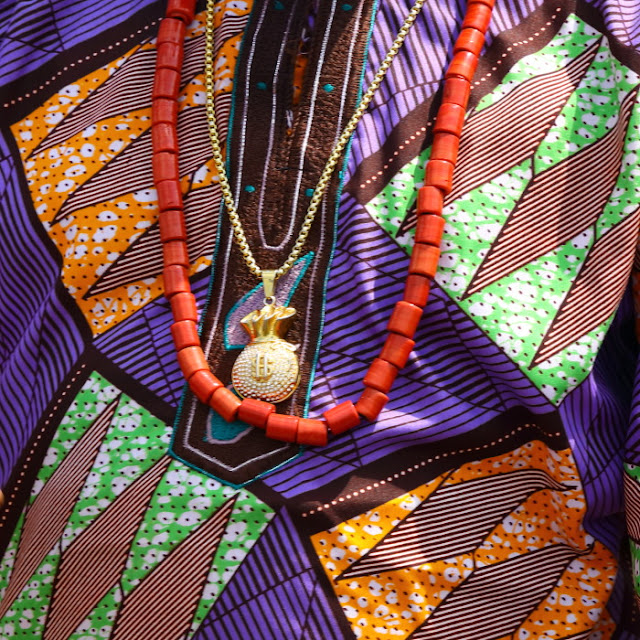 |
| a corner of the suspended lake on Ado Hill |
 |
| Otun's golden purse |
 |
| Ademola Olugbile Folakanmi, the Alado of Ado Awaye |
In the coronation brochure, we learn that Ado Awaye is the reunion of two communities totalling 300,000 inhabitants with another 100,000 inhabitants spread over a 100 villages in the immediate vicinity of Ado Awaye. Ado was founded on the Ado Hill at the beginning of the 16th century by Obakoyi, the crown prince of Alaafin Oluaso. It was probably part of the Yoruba expansion wave that led to the settlement of Abeokuta, Idanre, etc... Awaye was founded much later in 1815 by Belolari, a female line prince of Alaafin Agboluaje of Oyo. Ado settlers relocated at the foot of the hill when safety had improved.Today the economic activity is essentially centered on farming, but the Oyo Governor and the Alado are hoping to develop tourism in Ado Hill. There is also a large untapped deposit of first grade kaolin. Prayer mountains are also advertised, essentially places for Christian pilgrimages which can take the shape of a rock. There is a famous one called Agelu Jerusalem which has been popularized by the founder of the Cherubim and Seraphim church.
The visit of Ado Hill requires to be accompanied by local people, the three Chiefs in our case, because they know the place and can guide us to avoid some dangers. Indeed Iyake, as the suspended lake is called locally, is said to be no ordinary lake, it is believed to be bottomless and that there is only one equivalent on the Earth, which is located in Colorado, USA. A white man once entered it and never came back, it is therefore forbidden to bathe into the lake. People drink its water, though, which is apparently very pure and sweet.
 |
| the Chiefs, Otun, Aro and Balogun (left to right) |
We started the steep ascend using a staircase, the climb took perhaps twenty minutes to reach a first shrine dedicated to Isage. The shrine was materialized by a rock, four to six meter high, that sat next to the staircase without any ties to the rock below. The legend goes that any attempt to move the Isage rock was always frustrated and unsuccessful. It is worshipped for fertility. Children who are the result of the rock's power are paying their homage to Isage by drapping the rock with white clothes, they are symbolically covering their naked mother. We could see a white piece of cloth surrounding the base of the rock as well as dry grass. The deity is fed with food offerings. I saw another rock that was surrounded by white cloth a few hundred meters away too.
The rock of Ado Awaye has sixteen shrines. We did not see all the sixteen and the Chiefs did not seem to remember all of them very well. We left behind us an area shaded with trees, at the end of the staircase, to walk in the open, straight on the rock. Patches of burnt grass, man-triggered, gave the place a desolated twist. One of the patch had a baobab (ose in Yoruba), in its center, that had thankfully survived the fire. Baobabs could be seen in other part of the hill. We had come across one, on the way up, which had its trunk bent along the staircase but people said it did not matter, it had been like this for the past twenty years and it looked in good health judging by the quantity of fruits it was bearing, looking like light-brown velvety eggs.
Another baobab, also fallen down, looked like an elephant about to get up with his trump. This was considered a shrine.
 |
| the rock dedicated to Isage |
A village boy, who had followed us, was cooling down the heat from his body by moving up and down the bottom of his t-shirt. In the process, I saw he was wearing a small leather pouch around his neck. I asked what it was. He said it was a magical charm to protect him.
A few hundred meters further south was the famous suspended lake. It was tucked in the middle of rocks, triangular in shape. The water looked clean, some people drank from it, particularly the Chiefs. The water was very calm. It reflected the partially clouded sky and from one side the image of a tree growing on the shore perfected the view. Suspended or not, the lake and its settings were pristine, it looked like a pearl in its shell, away from the world and the noise of the nearby town, away from the view of the surrounding fields and woods. It was free of plants and animals unlike the Iya Laru pond.
 |
| Aro leading the way to the lake of Iya Laru |
All of us felt it was a blessing to have travelled all the way from Lagos to experience this beautiful and mysterious place.
As we descended the staircase, the noise of a funeral was filling-up the air. From our bird eye position, we could see marquees of different colours set-up on one of the streets out of which the sound of blaring speakers came to harass our ears. The deities had chosen the right place for their shrines up there on the hill!
Comments
Post a Comment